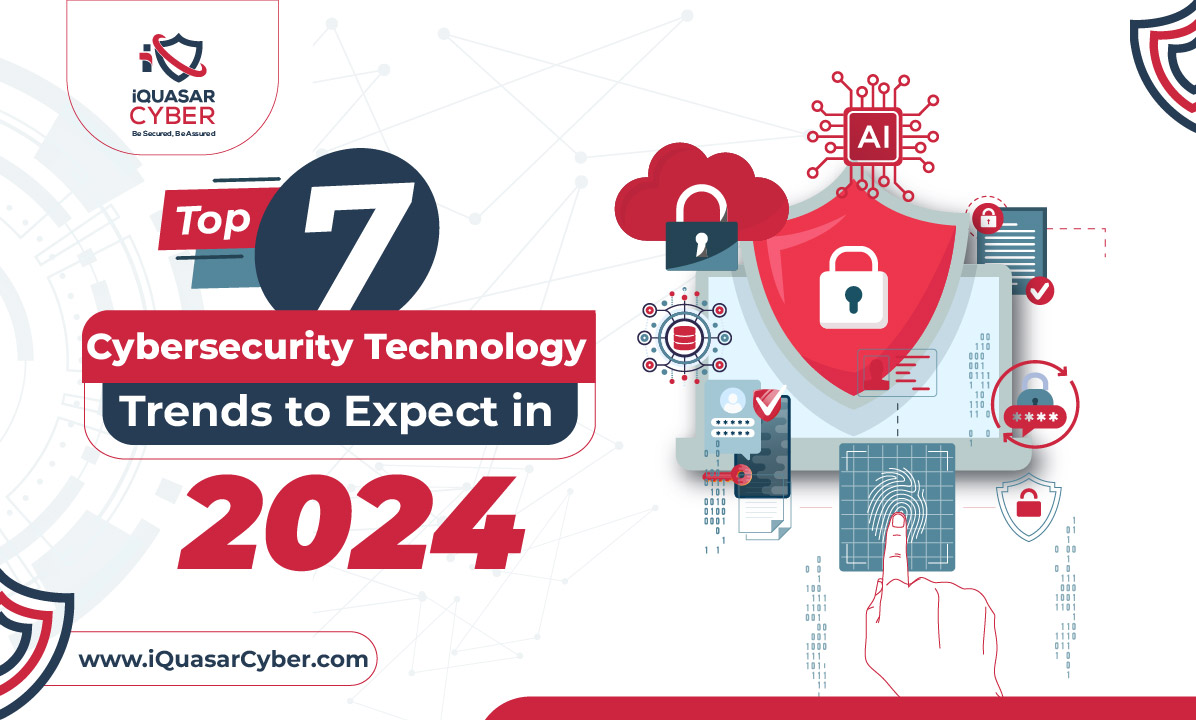Top Cybersecurity Technology Trends to Expect in 2024

1. Artificial Intelligence and Machine Learning Advancements
In 2024, AI and ML will play a pivotal role in offensive and defensive strategies. Cybercriminals will leverage AI to create sophisticated attacks, such as spear phishing, social engineering, and ransomware campaigns. Conversely, organizations will integrate AI-powered solutions into their security architecture to enhance threat detection, incident response, and vulnerability management.
Experts predict that AI algorithms will provide real-time threat analysis, enabling swift and precise responses to cyber incidents. Moreover, ML will likely advance to adapt and update cybersecurity protocols autonomously, reducing dependence on manual updates. We might even see the emergence of AI-driven security bots designed to detect and eliminate cyber threats independently.
2. Increased Focus on Cloud Security
With the growing adoption of cloud computing, cloud security will become a pressing concern in 2024. Organizations must ensure that their data and applications hosted in the cloud remain secure and compliant with regulatory requirements. Cybercriminals will target cloud infrastructure weaknesses, so implementing robust access controls, encryption, and monitoring tools is vital.
Gartner forecasts that cloud security spending will reach $215 billion in 2024, a significant increase from 2023. This investment will cover areas like identity and access management, data protection, threat detection, and incident response. To safeguard your organization’s assets in the cloud, partner with reputable providers and implement cutting-edge security solutions.
3. Stricter Regulations and Compliance
In 2024, governments worldwide will continue introducing stringent regulations to protect citizens’ data privacy and combat cybercrime. Organizations must adhere to these regulations or face hefty fines and reputational damage. GDPR, HIPAA, PCI DSS, CMMC, and CCPA are some laws requiring organizations to maintain adequate data protection standards.
To avoid noncompliance penalties, dedicate resources to understanding and meeting regulatory requirements. Implement frameworks like NIST, ISO 27001, or SOC 2 to demonstrate your commitment to cybersecurity best practices. Additionally, educate your staff about the significance of compliance and encourage them to follow established security policies.
4. Internet of Things (IoT) Security
The IoT market continues expanding, connecting an increasing number of devices to the internet. Unfortunately, this growth provides more entry points for cybercriminals. Inadequately secured smart devices can allow attackers to infiltrate networks, steal sensitive information, and disrupt services.
Organizations should prioritize IoT security by implementing segmentation techniques, utilizing secure communication protocols, and regularly updating firmware and software. Encourage employees to use strong passwords and monitor connected devices for suspicious activity.
5. Multi-factor Authentication
The era of depending solely on passwords for authentication is dwindling. Multi-factor authentication (MFA) is emerging as the standard for securing accounts and data. MFA enhances security by mandating users to provide multiple forms of verification—something they know (password), something they have (smartphone), and something they are (biometrics).
Anticipate MFA becoming a non-negotiable security practice in 2024 for both businesses and individuals. Its widespread adoption is crucial in mitigating the risk of unauthorized access, making it an integral component of cybersecurity strategies.
6. Zero Trust Architecture
Zero trust architecture operates under the assumption that no individual inside an organization shouldn’t be trusted; instead, everyone needs verification before accessing resources. This methodology gained popularity over recent years mainly due to how easily employees’ credentials could be stolen via phishing emails and utilized later internally launch attacks after gaining initial access.
Implementing zero trust principles limits potential internal threats, significantly reducing overall attack surfaces within organizations today.
7. Software Defined Networking (SDN)
In 2024, Software Defined Networking (SDN) stands out as a transformative trend, offering administrators centralized management platforms to define network behaviors based on predefined policies. By decoupling control planes from underlying hardware components, SDN grants IT staff greater flexibility in designing cutting-edge network topologies, harnessing the power of emerging virtualization technologies. This approach enhances network agility and sets the stage for more efficient and adaptive IT infrastructures.
Summing up, the cybersecurity landscape in 2024 is marked by a combination of technological advancements and evolving threats. Staying informed and proactive is crucial for individuals and organizations alike. At iQuasar Cyber, we understand the challenges that come with navigating the complex world of cybersecurity, which is why we offer comprehensive solutions designed to help you safeguard your business. Whether you need assistance with risk assessment, identity and access management, or security architecture, we’ve got you covered.